Sharlyn J. Lauby's Blog, page 92
September 24, 2019
Employees Want to Work with Technology In the Modern Cloud

(Editor’s Note: Today’s article is brought to you by
our friends at Kronos
, a
leading provider of workforce management and human capital management cloud
solutions. Managing your workforce just got a lot smarter with
Workforce
Dimensions, a solution designed to provide both a world-class employee
experience and unprecedented levels of operational insight
. Enjoy
the article!)
In the first part
of this series about the future of work, we talked about the need for organizations and individuals to work smarter. Part of working smarter is using the right
tools. This is where decisions about technology have an immediate impact on
work.
In a study
published on Training Magazine, respondents talked about employee stress and burnout being linked to using outdated
technology. I
hate to say it, but this totally makes sense. Employees who are forced to
create workarounds because they’re dealing with old technology are quickly going
to get frustrated. They’re doing double or triple the work and still being held
accountable to the same performance standard.
According to CIO
Magazine, 93 percent of Millennials consider technology to be the most important aspect of work. And I’ll just add that I honestly
believe this feeling extends beyond Millennials. No one wants to use 2-3
programs to get something done. So, what do employees what in terms of
technology tools? Two things:
They want to work in the modern cloud. This means providing technology and tools that empower employees to reach their full potential and work smarter while working their way.It also means configuring technology to align with the employee experience so it can create better outcomes for the organization, harness workforce innovation, and deliver exceptional results.
This may sound great in theory, but it’s actually really
hard to execute in practice. That’s because legacy solutions are often hard to integrate.
I asked Mike May, senior director of the Workforce Dimensions Technology
Partner Network at Kronos why technology integrations are such a challenge when
they’re so common in today’s business environment. “While tech integrations are
commonplace in any organization, they’re often limited to batch-based data
sharing at pre-determined times. Sometimes, the entire system actually has a
blackout period where no one can use it.
That’s just for data sharing. It’s even more challenging to embed one
solution inside another to offer employees a single user experience. Instead,
they’re still forced to master multiple applications, often left feeling
frustrated by the friction this creates with their actual priorities at work.”
Technology Partnerships Bring Together Strengths
The good news is that organizations don’t have to build a
customized solution. Technology solutions like Workforce Dimensions are
creating it through strategic partnerships and features that apply specifically
to your business and to your culture.
EXAMPLE #1: Microsoft and Google. While the Microsoft Office Suite is
widely used for business, Google’s G
Suite is also tremendously popular. Both platforms integrate with
Workforce Dimensions, giving managers the ability to work with tools they are
comfortable with.
Here’s an example of how they could be used alongside Workforce
Dimensions. Instead of tacking up a paper schedule on the breakroom cork board
or emailing the team a spreadsheet schedule, department managers can empower
employees to sync their schedules with a feature such as Google Calendar, where
they already track and plan their personal lives. This provides anytime access
to their schedule and makes it easier to plan work around life events.
Similarly, for managers who already spend all day working in
Microsoft Outlook, Workforce Dimensions integrates directly with the wildly
popular email client. This means they no longer have to leave Outlook and log
into Workforce Dimensions to review and approve time-off requests. Instead,
they get all the information they need in a special sidebar, saving them clicks
– and more importantly, time – while also responded to employee time-off
requests even more quickly.
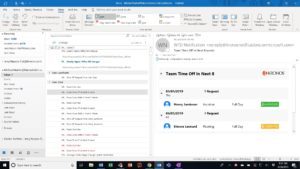 Instead of logging into Workforce Dimensions every time an employee requests time-off, managers can review and respond directly from Microsoft Outlook.
Instead of logging into Workforce Dimensions every time an employee requests time-off, managers can review and respond directly from Microsoft Outlook.EXAMPLE
#2: Rodio. If you’re not
familiar (I know I wasn’t), Rodio is an artificial intelligence chatbot that facilitates
conversations (like shift swaps). In today’s workplaces, email is not the most
predominant form of communication. And everyone’s emails are not prioritized
the same way, meaning people often delete emails without reading them. In a
traditional office, this may not be a big deal…that person will go out of their
way to convey the message. But what about employees in the field services industry
who spend all day on the road, traveling from location to location with
possibly little contact with their colleagues? Think telecom installation
techs, home health givers, and janitorial workers. Or transportation and
logistics, where long-haul truckers may be on the road for days at a time.
Rodio
segments or compartmentalizes information so employees are part of the right
conversations. The ones that make sense for them. The ones they need to pay
attention to. An added benefit in the Rodio technology is that it will
auto-mute when the employee isn’t working. Then send an ICYMI (in case you
missed it) message when the employee returns to work.

Bringing Partnerships to Reality Benefits Employee Performance
We regularly talk about the need to
align talent management strategy with business strategy. Organizations can do
that through the use of technology.
A month ago, I introduced you to a company
called Passport that helps organizations increase productivity when it comes to
responsive scheduling and driving routes. Well, I recently heard about a
partnership where Passport, Rodio, Forms.com, and Kronos partnered together to build a home
health services application on top of the Kronos D5 platform, which is the
foundation of Workforce Dimensions. The app is
called FieldCentric and it brings patient administration, route assignments, and
schedules together into a single, easy to use app. Employees no longer have to
log into several apps to get their jobs done. They can focus on taking care of patients.
This is becoming a bigger and bigger
focus for a dedicated team at Kronos – they’re developing a partner ecosystem
to not just create integrations but bring together multiple technology partners
to leverage what each does best to rapidly build new solutions that solve
unique workforce business challenges on top of Kronos D5. This is exactly what
we’re talking about. Giving employees a technology experience in the modern
cloud will not only benefit them but the organization’s bottom-line.
P.S. If you want to learn more about the Workforce
Dimensions solution and how it can benefit your organization by helping your
employees work smarter, visit the Kronos website and request a demo.
The post Employees Want to Work with Technology In the Modern Cloud appeared first on hr bartender.






September 22, 2019
The New Employee – Employer Social Contract

One of the workplace-related conversations
that’s happening with more frequency is focused on how new technologies such as
artificial intelligence and machine
learning are changing jobs. There are people who say that
computers are going to take away our jobs and others who say computers are
going to create new and different jobs. I’m kinda sitting in the camp of “both”,
meaning new technologies are going to eliminate some positions while at the
same creating new opportunities.
But it has occurred to me that the jobs
conversation is only one piece of it. I just finished reading Peter Weddle’s
book, “Circa
2118: What Humans Will Do When Machines Take Over”
while at the same time, taking the massive open online course (MOOC) from MIT
on “Shaping
Work of the Future”. While Weddle and MIT don’t always
agree on the future, I must admit that I enjoyed experiencing these two different
views at the same time. It helped me to realize that new technologies are
changing not only jobs but the employee / employer social contract.
For many decades, the employee / employer
social contract has been about employees receiving a living wage in exchange
for their work. And in turn, this would help employees achieve a stable life.
That philosophy is changing, because of society which includes technology.
Work is becoming – if it’s not already – a
social interaction. What happens to us at work impacts our well-being. This
means the entities that influence what work looks like need to change to keep
up with the times. For example, when it comes to technology:
Businesses can make investments in technology to benefit the operation. Organizations can use technology to make decisions and augment work. And the strategic use of technology can increase the profit line, allowing organizations to provide a better employee value proposition (EVP).
Education can shift toward a “lifelong education for all” not just in schools but for organizations. Individuals must continue to own their career development. This includes not just taking classes but learning how to identify skill needs like an increased focused on collaborative skill building as well as learning how to fail.
Government can be a catalyst for innovation. They can reduce bureaucracy, encourage public and private partnerships, be more open to invocation and change. Their efforts can be a catalyst for reducing global issues such as income inequality.
Labor can be agile, modern, flexible, and adopt a focus on career advocacy. We’re not talking about our parents’ unions. Unions have an opportunity to be strategic partners with business versus adversaries and help organizations achieve their goals.
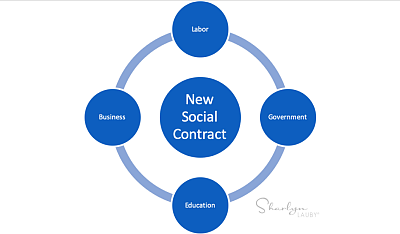
Technology advancements are shaped by us, so
we do have influence into the future of jobs. As HR pros, we need to be sure
that the jobs we’re creating have quality. Jobs will still exist in the new
technological environment and we know that the look of those jobs will be
different. That includes what skills will be required. Better education is a
must. But this means that with better jobs, better pay must come along with it.
We have an opportunity to educate people on
how to see and manage this big business altering change. We can do that by
adopting more of a both/and (versus an either/or) approach. Both at a business
level as well as with individuals. Our goal shouldn’t be to become “robot
proof”. In fact, the goal might be to collaborate with robots. Think of it as
working with Janet to get out of the “bad place” instead of fighting
with Janet. (Can you tell I’ve been binge watching “The Good Place”?
ha.ha.)
I know this is a big bundle to unpack and I admit that I don’t have all the answers. I do know that technology is changing work. All technologies aren’t necessarily great for business and we need to make sure technology works to realize its full benefit. We also have to ask ourselves, “Is the new social contract realistic?” HR professionals will want to keep technological trends on their radar and proactively develop an opinion about them before being forced to react to whatever is happening.
Image captured by Sharlyn Lauby after speaking at the SHRM Annual Conference in Washington, DC
The post The New Employee – Employer Social Contract appeared first on hr bartender.






September 20, 2019
Workplace Warrior: 5 Steps to Better Productivity
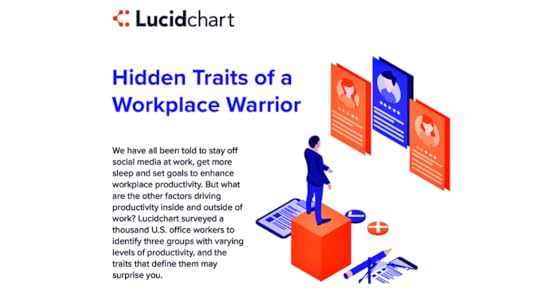
I’m always looking for ways to be productive
and I’d like to think that most people are as well. No one wants to waste their
energy. That’s why I was intrigued by this infographic from Lucidchart. They
conducted a survey to determine the ways people are more productive.

While some of their findings we can’t change,
like being the youngest makes you less productive. There were some common
themes worth mentioning. Here were my five big takeaways:
Stepping away from the computer. We regularly hear that finding time to disconnect from our technology is good for us. It doesn’t have to be for days or weeks. Simply setting clear boundaries can be just what we need to be more productive. For example, no devices during meals. Or no devices on date night.Curate your workspace. Personally, I love this one. I like being surrounded by fun things when I work. It makes me happy and I think my productivity is better. Even if you work in a traditional office environment, is there something you can do to your office space that will make you smile. Working from home. Not everyone has the ability to work from home, but if you can even have an occasional day away from the office…take it. I won’t lie; there’s something wonderful about working from home in your pajamas. Changing up your office environment can be a huge boost to productivity.Practice self-care. The infographic mentions diet and while I can see hunger being a distraction, I do believe in practicing good nutrition. I know I’m more productive when I eat right and exercise. I’m also more productive when I get a good night’s sleep.Breaks, lunches, and vacation! It may be tempting to postpone or not take time off because of the emails that will be waiting for you when you return. Resist this urge. We need our breaks, lunches, and time off. It allows us to turn off our work brains and return refreshed and perhaps even more prepared to tackle a big project.
Some of you might be saying, “This isn’t really a new list.” And that’s exactly the point. The things we can do to make us productive have been around for a while. Our challenge is often sticking to them. When we get busy or a big deadline is approaching, we might start to abandon these steps. Which impacts our productivity. Ultimately, it ends up being a self-fulfilling prophecy. So, consider today’s post a reminder. Take care of yourself and your productivity will take care of you.
The post Workplace Warrior: 5 Steps to Better Productivity appeared first on hr bartender.






September 19, 2019
SHRM Certification: 10 Proven Tips for Effective Study and Test-Taking
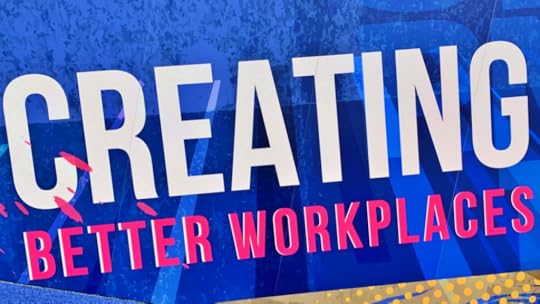
I’ve written before about the value of certification. I
believe being certified can set you apart and I think the process of becoming
certified can be educational and rewarding.
A few years ago, I had the privilege of working with the
Society for Human Resource Management (SHRM) as an item writer for their
certification exams and now I work with them to facilitate certification prep
seminars. I love being able to share my knowledge and help people earn their
certification.
One of the questions I’m asked a lot is “What tips do you
have for someone working toward their certification?” So, I’ve decided to share
with you my top ten tips. While this is focused on the SHRM credential, I’m
sure you can take these tips and apply them to any type of certification you’re
pursuing.
Get familiar with the SHRM Body of Competency and Knowledge (BoCK). First things first, the exam is based on the SHRM Body of Competency and Knowledge, also known as the BoCK. Want to know what’s on the exam? Review the BoCK. You can download the SHRM BoCK on their website. Also on the SHRM website is an interactive guide that allows you to read more about each competency and access career development resources.Learn about the exam itself. I believe one of the keys to success is understanding the exam details like the number of questions (160), format (multiple-choice), and time limit (4 hours). ICYMI, there’s a new book out from SHRM titled “Ace Your SHRM Certification Exam”. Among many other things, the book covers the exam structure and the two different types of exam questions. Determine which exam you want to take. SHRM offers two credentials: the certified professional (CP) and senior certified professional (SCP). It could make sense to do your research in tips #1 and #2, then decide which exam you want to earn. Each credential has its own eligibility criteria, so you’ll want to review each and decide for yourself. Create a study schedule. And stick to it! Yes, you are a knowledgeable, successful HR professional. But that doesn’t mean you don’t have to study. This is a standardized exam and many of us haven’t taken this type of exam for a while. So, plan to study. And make studying a priority. This is the top regret I hear from people who don’t pass the exam. They fall behind in studying and never catch up.Find a study buddy. Or a study group. If you’re concerned that you might be one of those people who could become easily distracted from your study plan, think about finding a study buddy or group to help with accountability goals. I’m one of the moderators for a Facebook group focused on certification study (and that’s all we discuss). It’s called The SHRMinators. You’re welcome to join us.Consider taking a prep course. I’m not just saying this because I teach prep courses. Some people find that taking a prep course at the beginning of their study helps them to focus. Some people take the prep course at the end of their study as a final boost before the exam. Either way, a prep course can help you achieve your certification goals. One thing I do want to add though, certification prep courses do not teach you what’s on the exam. Make yourself a set of flash cards. I just read an article on Lifehacker about “Using Old School Index Cards for Capturing New Ideas”. Index cards are inexpensive and a great way to jot down acronyms you want to remember or the essential elements for a piece of HR legislation. You can carry them with you and do a quick review while waiting at the dentist’s office. Take practice exams! There are quite a few SHRM study resources available that offer practice exam questions including the SHRM Learning System. I always like to say that the key to certification is 1) the content and 2) the exam. Taking a practice exam, studying, and then re-taking the exam can be a great way to gauge your study efforts and build confidence. Develop a ritual for answering questions. What I mean by this is, when you read an exam question, put a little process in place for yourself to answer the question. For example, “I’m going to read the question and all the responses. Then eliminate the responses I know are incorrect. Finally, I’ll choose the best answer.” It will take some time to turn this process into a habit, but it could help with second-guessing yourself on exam day. Practice self-care. Earning your certification is a big goal and it involves a lot of work. Taking care of yourself is important. Get plenty of rest. Eat well. Visit the exam center beforehand to see what it looks like. Be comfortable on exam day. I’d like to think that we would all agree that being stressed out isn’t the best approach for studying or for taking the exam.
Earning your SHRM certification can be a valuable step in
your career development. But I’m not going to sugar-coat it…earning your SHRM
certification is also hard work. Putting a plan in place to achieve your goal
will definitely help.
P.S. If you want to learn more about SHRM Certification Prep Seminars, check out the SHRM website. They offer both in-person and virtual programs as well as a new one-day “Power Prep” program which is focused on test-taking skills and specifically tailored to the specific exam levels – either CP or SCP.
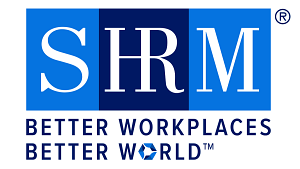
SHRM logo used with permission
The post SHRM Certification: 10 Proven Tips for Effective Study and Test-Taking appeared first on hr bartender.






September 17, 2019
How to Create Inclusive Employee Education Benefits

(Editor’s Note: Today’s article is brought to you by our friends at Bright Horizons EdAssist Solutions, which manages education benefits available to over 5 million U.S. employees. Be sure to check out the case study in Chief Learning Officer magazine showing how State Farm uses educational benefits to improve their recruiting and retention efforts. Enjoy the article!)
According to LinkedIn’s 2019
Workforce Learning Report, 94%
of employee say they would stay with a company longer if the organization
invested in their learning.
That’s a significant statistic. With unemployment at record lows, employee
retention is important. The LinkedIn report raises the question: How can
organizations invest in employee learning to improve employee retention? There
are two types of learning programs: we could label them as internal and
external.
Internal programs include technical
training, management and leadership development, mentoring, etc. These are
programs that are often developed and/or delivered by internal staff or
contractors hired by the company.
Then, there are employee educational
benefits, which I would put in the external category because the employee often
chooses the subject and the place of delivery. Two of the most common
educational benefits are student
loan repayment programs,
which we’ve talked about in the past, and tuition reimbursement, which is what
I want to focus on today.
4 Key Elements of Employee
Education Benefits
Before we dive into specifics
about tuition reimbursement programs, let’s spend a few minutes talking about
program design. Whenever we’re faced with designing any type of benefit, there
are four key elements we should consider. This is absolutely true for employee education
benefits.
ELEMENT #1 – Alignment with talent objectives. Employee benefits should help the organization recruit, engage, and retain the best talent. Benefits don’t have to be expensive to do that. They do need to be things that have value and employees want.
ELEMENT #2 – Communication to candidates and employees. In the Bright Horizons State of Education Benefits report, they draw a connection between program success and regular, proactive marketing of employee education benefits. Organizations need to remember that they cannot simply mention a benefit during an interview or in new hire orientation and think they’re done.
ELEMENT #3 – Relationships with strategic partners. Many employee benefits involve outside partnerships. Think health insurance, life insurance, gym memberships, food/snacks…you get the point. In the case of tuition reimbursement, we’re referring to both education providers like colleges and universities as well as third-party benefits administrators.
ELEMENT #4 – Attractive and available to all. I must admit that I saved this one for last and I want to spend a little extra time on it because I believe it’s the element that’s a big challenge for employers. What makes employee education benefits effective is inclusion and the way to be inclusive is through utilization. Bright Horizons shared with me that historically, across all industries, around 5% of employees make use of traditional tuition reimbursement programs.
In my opinion, when unemployment rates aren’t at historic
lows, organizations might find 5% utilization to be a great metric. But when
you think about the skills gap and employee retention challenges facing
organizations today, then it might be time to reconsider.
A benefit doesn’t become
effective by being created or documented. One could argue that a benefit that
no one uses really doesn’t even exist. It becomes effective and inclusive when
employees use it.
Now, I understand that an
education benefit will not receive 100% utilization. However, if organizations
want to reap the benefits that an education benefit offers, then utilization
needs to be higher. Go back to the LinkedIn statistic I mentioned at the beginning
of this article. If education benefits are linked to employee retention, then an
increase in participation should drive a corresponding increase in retention.
6 Areas that Can Create a More Inclusive
Education Benefit
If
your organization doesn’t already offer a tuition reimbursement program, now
might be a good time to consider one. And if you do offer one already, now
might be a good time to audit your existing program to make sure it’s something
that all employees would be interested in and able to use. Here are six areas
to consider:
Program
name. I know I’ve been using the word
tuition reimbursement throughout today’s article, but it might be time for a
change. It’s possible the word tuition is considered synonymous with going to college.
And education is about much more than that. Maybe “education assistance” is a
better way to describe the benefit.
Eligibility. According to Bright Horizons research, 74%
of organizations only offer tuition reimbursement to full-time employees. As
companies look to improve employee retention, they want to retain both
full-time and part-time employees. Especially in industries with a large
front-line workforce where part-time employees often move into full-time
positions.
Waiting
period. I was (happily!) surprised to
see in the Bright Horizons research that almost 40% of organizations do not
require a waiting period for employees to utilize tuition reimbursement. But
that still means many organizations do. Companies need to weigh the financial
cost of delaying access to the benefit against the results they’re missing out
on.
Financial
models. Asking employees to pre-pay for
their education and wait for reimbursement can be a huge barrier to
participation. Especially in industries with a large entry-level workforce.
Companies might want to consider working with their program administrator to offer
direct payments to education providers and remove the need for an up-front
payments by employees.
Education. What I mean by education is whether the only goal is a college degree related to the employee’s current position. It could make sense to expand the types of courses allowed to include general education diplomas (GEDs), language courses, certifications and/or credentials, as well as degrees in subjects that are valuable to the organization but not directly related to an employee’s current career path.
Delivery
models. Today’s technology allows
individuals to learn from practically anywhere. And the quality of online
education has significantly improved, with many new innovative high-quality
education options. Organizations might want to consider allowing massive open
online courses (aka MOOCs), exclusively online colleges, or even non-university
online education providers like the Society for Human Resource Management
(SHRM) to be included in educational assistance programs.
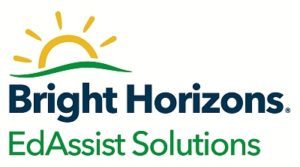
Use Employee Educational Benefits
to Retain Talent
Despite all of the news about the
rising cost of education, some newer education providers that are focused on
adult learners can provide a great learning experience at a much lower cost
than the traditional classroom-based approach.
Learning can be a way to attract,
engage, and keep talent. Employee educational benefits are a way to provide and
support learning opportunities. But those programs must meet the needs of all
employees, not just a handful.
If you want to learn more about designing an inclusive modern educational benefit, join me and the EdAssist Solutions team on Wednesday, September 25, 2019 at 12n Eastern for a webinar on “Open Access: Effective Education Benefits for Frontline Workers”. And of course, if you can’t make it…sign up anyway and get the recording. Hope to see you there!
The post How to Create Inclusive Employee Education Benefits appeared first on hr bartender.






September 15, 2019
9 Things to Consider When Purchasing HR Technology

We talk about HR technology a lot on HR Bartender, but it occurred
to me recently that’s there’s one area of HR technology we really haven’t
discussed. I was listening to one of the archived sessions from the Kronos
eSymposium titled, “Five Things Not to Overlook During HR Tech Vendor
Selection” and it reminded me we haven’t talked about buying technology.
With the HR Technology
Conference coming up soon, I thought it might be helpful to put together a
list of things to consider when you’re thinking about buying new technology.
It’s by no means a comprehensive list, but it’s one that can help start
conversations both internally with key stakeholders and with vendors.
Assess the organization. Is this a first-time implementation of technology or an upgrade to an existing system? What’s the budget? It could also be helpful to conduct a user analysis in terms of the level of tech savviness employees, managers, and even HR have. At some point, companies will need to prepare an overview of their current technology infrastructure and decide if it can support the new technology being considered.Establish the goal and must-haves. Companies need to answer the question, “Why is the organization considering this purchase?”. The answer will determine how they measure whether the technology investment was the right thing to do. The company will also want to establish what things are must-haves in the technology solution. For example, when talking about HR technology, are compliance tools a requirement? And if so, does it need to be at a federal, state, and local level?Prioritize customization and features. There are lots of things we would love to have when purchasing technology. That doesn’t mean we really need them all. The company should prioritize the must-haves (from #2) and nice-to-haves. A few things to think about are single sign-on, mobile responsiveness, data storage, real-time access, etc. Another conversation to have is about customization: how much needs to happen?Confirm the request for proposal (RFP) process. Technology is a major purchase for almost every organization. Find out who needs to be involved, what information needs to be on the proposal, and ultimately, what is the selection criteria.Understand the technology platform requirements. One of the details that organizations will want from prospective vendors is the type of technology infrastructure required for the new system. It’s also important to know if the new technology is compatible with existing HR systems and non-HR systems. For example, is the new technology compatible with all internet browsers?Witness first-hand the user experience. When it comes to HR technology, I like to think there are three user groups: employees, managers, and human resources. For employees, the user experience should mirror something similar to the technology we already use. For managers, it needs to provide real-time data for operational decisions. And HR wants a dashboard to produce reporting.Find out what type of user training support is provided. We want to find out not only about training during initial implementation but ongoing. And not just for HR, but for employees and managers. Remember the training needs to support every technology level. It should also be in a variety of formats – blogs, community forums, webinars, user conferences, etc.Ask about implementation plans. There are obvious questions such as, “How much time does it take?”. But organizations also want to know the level of support that the vendor provides. For major implementations, I’ve heard of companies partnering with a third-party firm (that has a strategic partnership with the vendor) to oversee the implementation. Of course, those are logistics that must be considered as part of the proposal.Determine how updates and maintenance will be handled. While this might be the last number on the list, it really goes back to #1. Think about the type of organizational culture you have when it comes to technology. Do you consider yourself as an “early adopter” or does the company like to wait a while to implement updates? This is going to factor into the decision. Also, companies need to decide who will be responsible for updates and get that person involved. Finally, it’s important to know what role (if any) the vendor will play and ongoing maintenance costs.
As you can see, we’ve only scratched the surface of the questions and decisions that need to be considered when purchasing technology. But it’s a start. I could see companies having conversations about #1-5 prior to a conference like HR Tech. Then spending time during the event focused on #6. And #7-9 being follow-up after the event.
Bottom-line: Buying technology involves making a plan. And it’s better to have a plan before talking to vendors. It could make the process so much smoother.
Image captured by Sharlyn Lauby while exploring Disneyland in Anaheim, CA
The post 9 Things to Consider When Purchasing HR Technology appeared first on hr bartender.






September 13, 2019
Employee Absences: Plan for the Unplanned
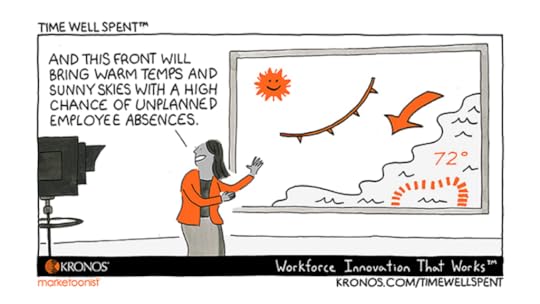
I must admit today’s Time Well Spent
from our friends at
Kronos is a little funny to me for two reasons.
Living in Florida, we often run into these “the weather is absolutely gorgeous days” where we want to play hooky and go to the beach. And sometimes we actually do it. We’re also famous for gloating in January and February about wearing shorts when our friends are posting snowstorm pictures on their Facebook pages. Then there are moments like today when, in between writing this article, I’m pulling together my Hurricane Dorian supplies. It’s 80 degrees and the sun is shining, but we’re prepping for a few days with no electricity. Ah, it’s the price we pay for living in paradise most of the time.
The bottom line is, whether it’s reason number
one or two, unplanned employee absences do happen. There are also a plethora of
other reasons that employees might unexpectedly not show up for work. Like
a car accident. Or a sick child or parent.
Even when employees have tremendous
flexibility in their schedules, unexpected absences do happen. That doesn’t
mean the employee, or the organization should have to suffer when it comes to
getting the work done.
Give employees a quick and easy way to report their status. Hopefully, the employee isn’t hurt or ill. Hopefully, nothing catastrophic has happened. Or something terrible is happening with their family. However, when something does happen, employees should be able to focus on themselves, their family, or their home. They shouldn’t have to spend their precious time calling in or waiting on hold to speak with a supervisor. Use technology to give employees a quick way to inform their manager what’s going on and that they will call back later.
Allow employees to pick up extra work and shifts. When an employee does call out, the work still needs to be done. Organizations should have a way to immediately get the word out that there are extra shifts or work. This gives employees who are in a position to pick up some extra work the opportunity to rearrange their schedule and help the company (and maybe themselves) out. It could be as simple as texting another family member to pick the kids up after soccer practice. Or asking a friend if they can help a parent make dinner. The point is, employees might be able to pick up extra work if they have the ability to easily rearrange their schedules.
Stay in touch with employees who are out of the office. I know we’re talking about unexpected employee absences today. But another aspect of absences that needs to be addressed is letting employees know that they’re missed, and that work isn’t simply piling up on their desk. Give employees the space they need to take care of their business but also let them know that the organization is supporting them during this time.
Employees at every level of the organization
have unexpected things happen. Organizations should have the plans and
technology in place to deal with the unexpected. It will make the surprise much
easier to bear.
The post Employee Absences: Plan for the Unplanned appeared first on hr bartender.






September 12, 2019
5 Different Types of Roles You Want On Your Team

I must admit I’m not usually a big fan of
these types of lists because they typically have very hokey labels for roles. But
during a WordCamp
Orlando event, someone presented a team list that I
thought was pretty good. They presented it in the context of building a
community, but as I was listening it made me realize that the teams we are a
part of are communities in a way.
My one word of caution about this list. Please
notice that I’m using the word “roles” and not “people”. We’re complex beings.
We’re not one dimensional. It’s possible an employee will play one role in a
certain situation and a different role in another.
Cheerleaders:
This role provides support. They might not have a means or authority to help in
terms of approving resources or the power to make an obstacle go away. But when
you’re having a bad day, they will be there for you.Teachers:
They provide subject matter expertise both in terms of maneuvering through office
politics but also in terms of technical expertise. Most importantly, they are
willing to share their expertise with the team.Helpers:
This role is willing to help. Sometimes it’s because they like you. Sometimes
it’s because they believe in the mission or goal you’re working on. Naysayers:
They are the haters, trolls, etc. You must prove yourself with them OR ghost
them and don’t give them credence. It’s important to note that sometimes you
might be the naysayer leading the group. Watchers:
This role is waiting to see if the effort will succeed or fail. If it fails,
they will be the first to say, “I told you so.” If it succeeds, they will try
to copy it.
When
you’re building a team, you will have all of these roles on it.
And dare I say that it might be better to intentionally look for people to play
these roles. Even the naysayer and watcher roles. It will force us to think of
the challenges ahead and proactively search for the value proposition.
Sometimes it’s easy to surround ourselves with the cheerleaders, teachers, and
helpers. Then we get blindsided when negative feedback arises.
As you bring the team together, have a
conversation about how
the team will communicate. Here are three rules to consider:
Give team members a platform or medium to communicate. Team members need a place to talk about the projects they’re working on. It could be an enterprise collaboration solution or a small private group on Facebook. The important thing is that everyone feels a part of the team community.
Ask team members for a commitment to safe and confidential communication. When you’re working on a team, there will be times when the group will celebrate and moments when they need to vent. Team members should feel safe when communicating with other members.
Sustain
good communications through consistency. When I see teams struggle, it’s often
in the area of communication. And it’s because team members aren’t following
communication rules #1 and #2. There are sidebar conversations, gossiping, etc.
Team leaders need to maintain consistency.
Developing
a high-performing team is hard and it takes time.
But if we give people permission to play different roles, it could strengthen community
within the team. In fact, maybe we could even go to individuals when we ask
them to be a part of the team and say, “I’d like for you to be a bit of a
naysayer. Make me convince you this is a good idea. Because if I can convince
you, then we can sell the value to everyone else.”
The other thing to consider is as you’re putting together a team, what role are you going to play?
Image captured by Sharlyn Lauby while making cinnamon rolls for her team.
The post 5 Different Types of Roles You Want On Your Team appeared first on hr bartender.






September 10, 2019
Engagement or Connection: Why the Connected Workplace Might Be Better

(Editor’s Note: Today’s
article is brought to you by
our friends at MindManager
, a division of Corel Corporation. MindManager helps
individuals, teams, and enterprises do great work faster by simplifying the way
they capture, organize, and share information.
You
can try MindManager out for free here
. Enjoy the article!)
I’ve been seeing the term
“connected” workplace showing up a bit more in my reading. It’s piqued my curiosity,
so I decided to do some digging to learn more. While I haven’t found a single
definition for it, I have come to realize that “connected” might be a more
accurate term than engagement. When we think about employee engagement, we
often talk about employees being engaged with their work or their position or
the company. The employee is engaged with something.
Connected comes across to me as
employees are engaged with many things at the same time. They’re connected to
their work and the company, but also with other people such as their
co-workers. It made me think of “connected” as the
internet of things (IoT) for workplaces.
As such, I immediately thought of three things that could create a connected
workplace. We could call them the 3 Ts of a connected workforce – tasks, tech,
and team.
Tasks: Of course, the employee needs to be connected to the work they do. This doesn’t mean that there won’t be some job responsibilities we favor more than others. That happens everywhere. But the idea is that, overall, employees enjoy their work and feel that when they do their job well, they are connected with and contributing to the organization. Technology: Speaking of tasks, today’s technology solutions allow employees to use technology to make their work (i.e. tasks) easier. Technology can reduce steps in a process. It can supply information that would be otherwise unavailable (and do it in real-time!) Technology can also be used as a communication tool to keep the flow of information going and maybe reduce a few meetings. Team: Even when you’re an individual contributor, it’s necessary to get the work done with others. Employees need to be connected with their manager and colleagues. Of course, this happens directly through face-to-face meetings and one-on-ones. But employees can also build connection with others by using technology.
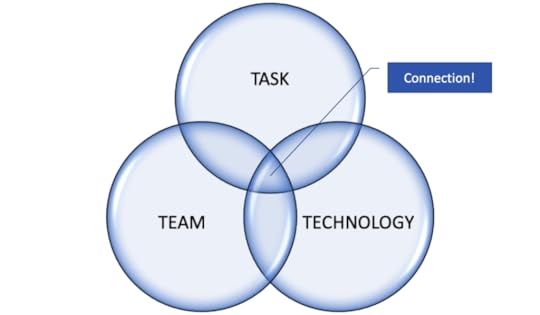
3 Ways Organizations Can
Create a More Connected Workplace
Here’s the thing: To create a
connected workplace means giving human resources and department managers the
tools to be successful. We could say that HR and management need to be
“connected” in order to pull this off. Ah, see what I did there?! Ha.ha. Sorry,
bad pun. But you have to admit that to create engagement, connection, whatever
you want to call it, HR and management have to work together. Here are three
key activities where HR and management have the opportunity to engage employees
and create a connected workplace.
Job
design: Developments in technology
necessitate looking at job design with a different eye. We’re not talking about
robots eliminating our jobs. Or maybe we are just a little bit. Organizations
have to start
designing jobs that are attractive to candidates and employees. This means HR and hiring managers need to
review job descriptions and discuss hiring requirements during the recruiting
strategy meeting and check their assumptions throughout the entire hiring
process.
Job
tools: While there are many different
types of job aids and tools, what I’m talking about here is technology. Organizations
need to provide employees with the tools to be successful. Candidates and
employees do not want to work for companies that offer an outdated technology
experience. It sends the message that the organization might not be able to
compete in the global economy. It also means that employees will have to craft
their own workarounds to get their jobs done.
Job
conversations: This is the one that I believe needs
the most attention. If you look up the definition of the word conversation, it means
a “talk between two or more people in which news and ideas are exchanged.” We
conduct conversations all the time, especially during meetings. But
conversations are also about listening and all participants being involved. It
reminds me of that old book, “Telling
Ain’t Training”. Telling also isn’t a
conversation.

How Organizations Can
Create Better Conversations
In many organizations,
recruitment challenges have caused HR and hiring managers to look at job design
and even add some new job tools. Unfortunately, when we look at the three ways
to create a more connected workplace above, the part that can be lagging is job
conversations. I wonder if it’s because conversations can be viewed as “easy”,
but the reality is that a quality conversation is hard.
Conversations
need to involve people. I
know you’re reading this and saying, “Yes, this is obvious.” But then, how many
times do we go to a meeting where the right people aren’t present?! I see it
happen a lot when the organization has remote employees or a contingent
workforce.
Conversations
need for people to be present. What I mean by present is that the environment is right
for the conversation (i.e. right time, place, atmosphere, etc.) and the right
technology for everyone to participate. Logistics are important because the
wrong time or place can ruin a conversation in a heartbeat.
Conversations
need to have purpose. In the Harvard Business Review
article “Collaboration
Overload”, we learn that the amount of
collaborative work has doubled over the past decade. For collaboration to be
successful, everyone must be on the same page in terms of understanding the
goal and the information being shared.
Connected
workplaces are not likely to happen organically. The organization needs to be
committed to having conversations. And committed to training managers and
employees on how to have good conversations. And finally, companies need to be
committed to creating a workplace where conversations are encouraged.
I
know there’s been a lot of conversation about employee engagement in recent
years. That’s not a waste of time. However, maybe instead of focusing on
employee engagement, organizations would be better served to focus on creating “connections”
around the workplace using the tools they have at their disposal – good work
design, excellent technology, and informative training and development – to
build those connections. Then watch the engagement grow!
P.S. If you want to learn more about creating a connected workplace, join me and the MindManager team for #WorkConnected on Thursday, September 26, 2019. Jean David, the pioneer behind Cirque du Soleil will be speaking about how they use working connected to enhance innovation and creativity in their organization. Already committed? No worries. Sign up anyway and get the recording.
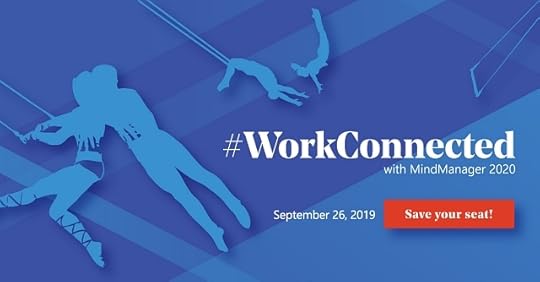
The post Engagement or Connection: Why the Connected Workplace Might Be Better appeared first on hr bartender.






September 8, 2019
Everything HR Needs to Know About Supply Chain Management

I had the opportunity this summer to attend SAP Ariba LIVE, an event focused on e-procurement and supply chain management. Now you might be saying to yourself, “What does HR have to do with supply chain?” The answer is – a lot.
First of all, as
human resources professionals, we are responsible for helping the organization
find talent. That includes supply chain management professionals. Second, when
it comes finding talent, many organizations are increasing their use of
external workers (i.e. freelancers, contractors, and consultants). HR has a
role in this process. It’s simply not a “hire the cheapest” person. Companies
have to find the right contractor, just like they have to find the right
employees.
Finally, I’ve
said before that organizations are focused on performance. Part of that
conversation has to do with how products and services get to market. That’s supply
chain. And human resources professionals who want to make the connection
between talent management and business results might want to spend some time
learning more about supply chain management and its relationship to talent
management. To help us understand more, I spoke with Leah Knight, senior
director of supply chain marketing at SAP Ariba.
Leah, before we
dive into specifics about what supply chain involves, let’s talk about the
“Why?” Why should human resources professionals be knowledgeable about supply
chain?

[Knight] Supply
chain is a growing and rapidly evolving field. Gartner has done some research
on the supply chain of the future and anticipates that there may be a shortage
of qualified supply chain staff because of this skill set evolution. Technology
skills are becoming increasingly important in this field, and human resources
may be called upon to find professionals in a discipline where they are
difficult to find.
Consider over the
past 5 to 10 years how supply chain technology, especially integrated business
planning, has changed the role of the supply chain planner from doing number
crunching on Microsoft Excel to today’s supply chain planner, who uses software
with highly sophisticated mathematical algorithms that help to build their
production plans – across regions, factories, product lines, and a complex web
of suppliers, logistics partners, and contract manufacturers.
Please also
consider how supplier collaboration technologies have led to a similar shift in
skill set: from manual collaboration – e.g., asking a supplier over the phone
or email whether s/he can commit to a forecast – to now using automated
collaboration tools that leverage Web services, XML, Cloud technologies, AI,
machine learning, and mobile.
I expect that the
HR function will become more important to the supply chain as their need for
technologically savvy professionals continues to grow.
Just to make sure
that everyone is on the same page, tell us what supply chain management
involves? And how does it relate to procurement or purchasing?
[Knight] There
are typically two components to supply chain management:
First, the supply
chain function owns the management of goods and services in support of
production, the related flow of these goods, and the supporting information.
This responsibility includes managing raw materials, work-in-process, and
finished goods as they flow from supplier or distribution center to various
manufacturing locations across the globe. It also includes contract
manufacturing, tolling, co-packing, and/or logistical services; and returns.
Supply chain professionals typically concern
themselves with long-term planning
(e.g., forecasts of a 6 month or more time horizon for these goods); mid-range
and near-term execution of inventory programs (e.g., consigned inventory,
supplier-managed inventory); quality of supply, work in progress (WIP) and
finished goods; delivery; replenishment of customer warehouses; etc. The
typical key performance indicators (KPIs) include:
Customer service (measured in terms of on-time/in-full deliveries, stockouts, revenue upside), Working capital / inventory efficiency (measured inventory turns, days inventory, inventory aging, etc.),Inventory and finished goods quality, and Productivity.
Next is the supply
chain / direct sourcing area. It’s also known as ‘commodity management’, ‘buyers’,
or ‘direct procurement’ in some industries. This area owns the sourcing and
contracting of raw materials, components, assemblies and related services (such
as contract manufacturing, tolling, co-packing, and logistics services). These
suppliers and services are needed to design, produce, and deliver their final
products.
Supply chain professionals also make a build
versus buy decision – that is,
deciding whether it is more effective to engage a contract manufacturer or
supplier for components, rather than building the components themselves. The
typical KPIs are:
Cost of materials
(including whether they achieve annual or quarterly cost reduction targets), Cycle time (e.g.,
the time required to complete a source-to-contract process), Team productivity,
Supplier quality,
and Supplier risk.
During SAP Ariba
LIVE, I learned how
Cirque
du Soleil is using an integrated dashboard
for its supply chain needs, which included
talent. Can you share with readers how supply chain technology is impacting HR
today?
[Knight] Supply
chain technology requires an evolution in skill sets for supply chain
professionals. Cloud technologies are requiring an interesting further shift,
because many supply chain professionals are embracing Cloud technologies in
order to bypass the queues, long lead times and/or competing projects in their
IT departments. Cloud technologies can be selected directly by the supply chain
department, but this requires an added level of technology evaluation and
selection, and ongoing collaboration with technology vendors that once may have
been the purview of IT, rather than supply chain.

Last question. I want to shift our conversation from the recruitment and development of supply chain professionals to another aspect of talent. One of the discussions I heard during the conference was about human trafficking and the need for organizations to understand more about their talent sources. How can supply chain and HR professionals work together to make sure that they are using ethical sources?
[Knight] Supply
chain/sourcing professionals own the selection of sources, which means they
have a significant and lasting impact into their organizations’ use of ethical,
sustainable, and diverse sources. One opportunity is to ensure that they do a
thorough supplier qualification process that includes such factors as
sustainability, ethical business and social practices, and diverse or inclusive
business practices. And then to ensure that only suppliers that are qualified are
allowed to participate in sourcing/supply chain opportunities.
But in my
experience, a one-time check is not enough. Ongoing monitoring is very
important, especially in our global, disaggregated supply chains, where a
supplier of a supplier can lead to unethical or non-sustainable practices in
anyone’s supply chain.
I want to extend a huge thanks to Leah and the SAP Ariba team for
giving me the opportunity to learn more about supply chain management. If you
want to learn more about how supply chain management brings value to the
business, check out
the SAP Ariba Resources Page on their website.
Given the challenges in today’s talent market, I only see the increased need for HR and suppliers to partner. The time to start building those relationships is now.
Image captured by Sharlyn Lauby while exploring the streets of Key West, FL
The post Everything HR Needs to Know About Supply Chain Management appeared first on hr bartender.






Sharlyn J. Lauby's Blog
- Sharlyn J. Lauby's profile
- 10 followers



